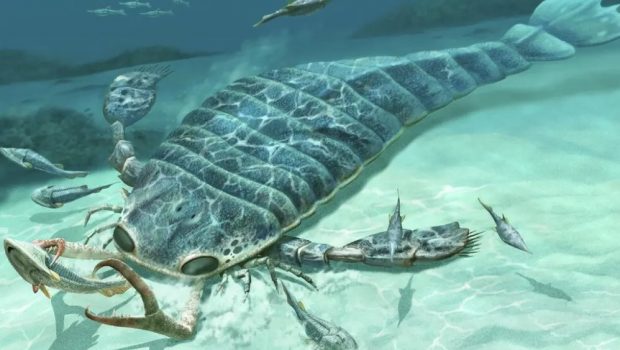
Imagine you are swimming on the beach of the Aegean Sea and suddenly a huge scorpion, over 2.7 metres long, appears from below. Fortunately, today the scorpion fits in the palm of your hand, but it was once the king of the seas, due to its hunting qualities.
What are commonly known as “sea scorpions” were a diverse group of arthropods called eurypterids, which appeared in the oceans of the Paleozoic Era more than 400 million years ago.
Scientists first became aware of these creatures when 150 fossils of this strange and terrifying creature were found about ten years ago at the bottom of the Iowa River in the United States of America.
However, new research by American Museum of Natural History paleontologist Rusk Bicknell and colleagues, published in the journal Gondwana Research and based on Australian fossils, reveals that the largest sea scorpions were able to cross oceans, a discovery that “goes completely beyond what we know arthropods can do,” he said.
The research results support the ability of sea scorpions to cross oceans.
Most eurypterid fossils come from North America and Europe, with some recently discovered in China. While some eurypterid fossils have been reported previously in Australia, these were fragmentary remains and it is difficult to determine whether they were the largest sea scorpion species.
However, Bicknell’s study has recorded a new set of eurypterid fossils from Australia. These are also fragments, but they are easier to identify as suspects because they can be identified.
The findings support the ability of sea scorpions to cross oceans, which is no mean feat. “It’s really cool to see that they’ve traveled a long way,” Bicknell said.
“They were effectively acting like sharks,” Bicknell said. With massive claws and a thick, powerful set of legs for swimming, the largest sea scorpions probably ruled the seas.
Scientists believe that the fact that giant sea scorpions make long journeys, even thousands of miles, suggests that gigantism may play an important role in migration.
It’s possible that animals simply needed a large body to survive in the oceans, like great white sharks and whales today, said Dr. James Lumsdale, a paleontologist at West Virginia University. Once the sea scorpions were big enough, they could make the journey.
The Great Secret of Disappearance
However, as terrifying as these arthropods were to their Paleolithic prey, they disappeared without a known cause. The eurypterid fossil record peaked during the Silurian period, which began about 444 million years ago, and then disappeared abruptly after the end of the Early Devonian period about 393 million years ago.
This sudden turn of events has left scientists baffled. “They show up, start doing well, get really big and then disappear,” said James Lumsdale. “They were dominant for a while and then they disappeared.”
Giant arthropods have not appeared since then, and a better understanding of how widespread giant sea scorpions were could lay the groundwork for explaining why.
But what makes sea scorpions so large and so successful worldwide remains a mystery. “Over time, there will be more discoveries,” Lumsdell said. “Then we will have a better idea of what’s going on with these animals.”
With information from The New York Times, Newsweek

“Total alcohol fanatic. Coffee junkie. Amateur twitter evangelist. Wannabe zombie enthusiast.”





More Stories
Is this what the PS5 Pro will look like? (Image)
Finally, Windows 11 24H2 update significantly boosts AMD Ryzen – Windows 11 performance
Heart Surgeon Reveals The 4 Things He ‘Totally Avoids’ In His Life